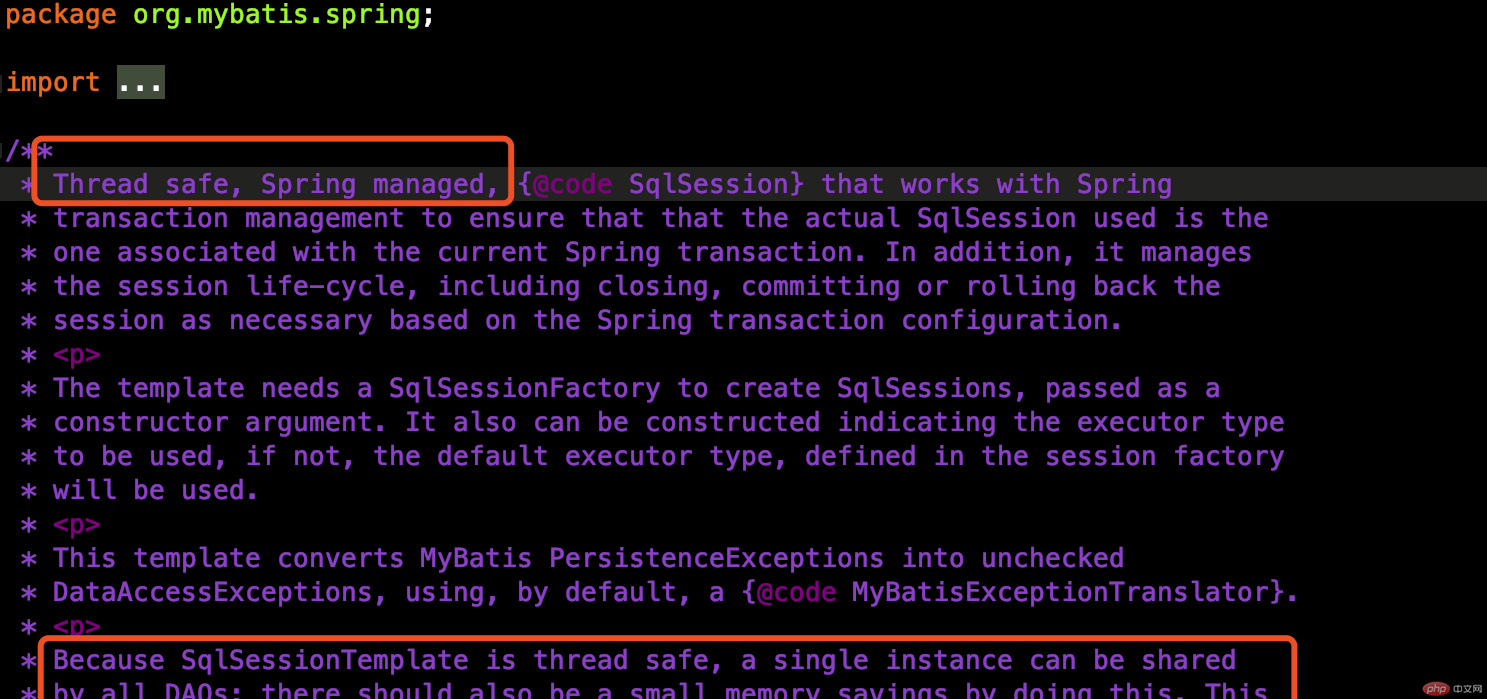抛出问题
1、Mybatis 开发为何通过接口就可以执行sql?
首先、有一点我们很清楚,在Java中 接口是无法被实例化使用的。
既然我们没有提供实现类,那么我们可以很自然的猜测是Mybatis帮我们生成了实现类。
直接上源码看下,Mapper接口动态代理的处理器类
1、MapperProxy
public class MapperProxy<T> implements InvocationHandler, Serializable {
private static final long serialVersionUID = -6424540398559729838L;
//sql执行的顶层接口
private final SqlSession sqlSession;
//mapper接口
private final Class<T> mapperInterface;
//mapperMethod缓存
private final Map<Method, MapperMethod> methodCache;
//动态代理的构造函数、同时代理多个对象,持有多个真实对象
public MapperProxy(SqlSession sqlSession, Class<T> mapperInterface, Map<Method, MapperMethod> methodCache) {
this.sqlSession = sqlSession;
this.mapperInterface = mapperInterface;
this.methodCache = methodCache;
}
@Override
public Object invoke(Object proxy, Method method, Object[] args) throws Throwable {
//判断如果是调用Object的方法,如:toString()、equals()等执行反射执行。
if (Object.class.equals(method.getDeclaringClass())) {
try {
return method.invoke(this, args);
} catch (Throwable t) {
throw ExceptionUtil.unwrapThrowable(t);
}
}
//缓存mapperMethod
final MapperMethod mapperMethod = cachedMapperMethod(method);
//通过mapperMethod,执行sql
return mapperMethod.execute(sqlSession, args);
}
private MapperMethod cachedMapperMethod(Method method) {
MapperMethod mapperMethod = methodCache.get(method);
//当前mapperMethod被缓存,则设置缓存。
if (mapperMethod == null) {
mapperMethod = new MapperMethod(mapperInterface, method, sqlSession.getConfiguration());
methodCache.put(method, mapperMethod);
}
return mapperMethod;
}}123456789101112131415161718192021222324252627282930313233343536373839404142观察MapperProxy,我们可以看出这是一个典型的jdk动态代理实现,与上篇示例不同的是,MapperProxy是mapper接口的处理器类,内部持有多个真实对象,也就是说它基于多个对象进行了增强。查看invoke方法,可以认为它进行对增强操作就是mapperMethod缓存和sql执行。
它是被谁调用,在什么时候使用呢?
2、MapperProxyFactory
public class MapperProxyFactory<T> {
private final Class<T> mapperInterface;
private final Map<Method, MapperMethod> methodCache = new ConcurrentHashMap<Method, MapperMethod>();
//构造函数接收一个mapper接口
public MapperProxyFactory(Class<T> mapperInterface) {
this.mapperInterface = mapperInterface;
}
public Class<T> getMapperInterface() {
return mapperInterface;
}
public Map<Method, MapperMethod> getMethodCache() {
return methodCache;
}
//通过Proxy#newProxyInstance创建代理对象
@SuppressWarnings("unchecked")
protected T newInstance(MapperProxy<T> mapperProxy) {
//最终返回一个动态代理生成的代理对象
return (T) Proxy.newProxyInstance(mapperInterface.getClassLoader(), new Class[] { mapperInterface }, mapperProxy);
}
public T newInstance(SqlSession sqlSession) {
//创建mapperProxy对象,这个就是我们的真实对象,也就是mapper接口的实现类
final MapperProxy<T> mapperProxy = new MapperProxy<T>(sqlSession, mapperInterface, methodCache);
return newInstance(mapperProxy);
}}123456789101112131415161718192021222324252627282930MapperProxyFactory类,见名知意,它就是MapperProxy的工厂类,负责生成Mapper接口的动态代理类,通过代理类执行sql。可以这样理解: 执行过程中生成的MapperProxy实例就是具体Mapper接口的实现类。因此,我们才可以通过接口直接执行sql.
2、SqlSessionTemplate 是如何实现线程安全的?
首先、mybatis原生提供的DefaultSqlSession是线程不安全的。
在Mybatis-Spring整合包中,为我们提供了线程安全的SqlSessionTemplate.
查看SqlSessionTemplate源码类注释可以看到,明确说明,它是被Spring管理的、线程安全的、单例类,可以被多个DAO共享。这是如何实现的呢?
这个问题在MapperFactoryBean源码解析查看,这次我们看下它关于动态代理的实现。
在SqlSessionTemplate中通过内部类,SqlSessionInterceptor实现InvocationHandler接口作为一个动态代理处理器类。
private class SqlSessionInterceptor implements InvocationHandler {
//没有内部对象,但是可以调用外部SqlSessionTemplate的。成员变量
@Override
public Object invoke(Object proxy, Method method, Object[] args) throws Throwable {
//进行了spring事物相关的增强。
SqlSession sqlSession = getSqlSession(
SqlSessionTemplate.this.sqlSessionFactory,
SqlSessionTemplate.this.executorType,
SqlSessionTemplate.this.exceptionTranslator);
try {
Object result = method.invoke(sqlSession, args);
if (!isSqlSessionTransactional(sqlSession, SqlSessionTemplate.this.sqlSessionFactory)) {
// force commit even on non-dirty sessions because some databases require
// a commit/rollback before calling close()
sqlSession.commit(true);
}
return result;
} catch (Throwable t) {
//异常处理、释放资源。
Throwable unwrapped = unwrapThrowable(t);
if (SqlSessionTemplate.this.exceptionTranslator != null && unwrapped instanceof PersistenceException) {
// release the connection to avoid a deadlock if the translator is no loaded. See issue #22
closeSqlSession(sqlSession, SqlSessionTemplate.this.sqlSessionFactory);
sqlSession = null;
Throwable translated = SqlSessionTemplate.this.exceptionTranslator.translateExceptionIfPossible((PersistenceException) unwrapped);
if (translated != null) {
unwrapped = translated;
}
}
throw unwrapped;
} finally {
if (sqlSession != null) {
closeSqlSession(sqlSession, SqlSessionTemplate.this.sqlSessionFactory);
}
}
}
}12345678910111213141516171819202122232425262728293031323334353637我们知道它只是动态代理的处理器类,必然有调用者调用传入代理对象接口才能生效。
查看SqlSessionInterceptor的调用者:
public SqlSessionTemplate(SqlSessionFactory sqlSessionFactory, ExecutorType executorType,
PersistenceExceptionTranslator exceptionTranslator) {
notNull(sqlSessionFactory, "Property 'sqlSessionFactory' is required");
notNull(executorType, "Property 'executorType' is required");
this.sqlSessionFactory = sqlSessionFactory;
this.executorType = executorType;
this.exceptionTranslator = exceptionTranslator;
//Proxy#newProxyInstance创建类代理对象,对SqlSessionTemplate进行增强。
this.sqlSessionProxy = (SqlSession) newProxyInstance(
SqlSessionFactory.class.getClassLoader(),
new Class[] { SqlSession.class },
new SqlSessionInterceptor());
}123456789101112131415当SqlSessionTemplate相关方法被执行时,会被处理器进行增强处理,在这里即是对Spring事物相关的增强。
三、本篇总结
学习了在Mybatis中,两处关于动态代理的实现收获:
1、动态代理的使用:处理器类可以持有多个真实对象,进行增强。
2、动态代理的处理器类可以通过内部类方式实现。
3、为使用动态代理提供很好的范例,除了单一的直接创建对象,既可以通过工厂方式生成、也可以通过构造器使用。

